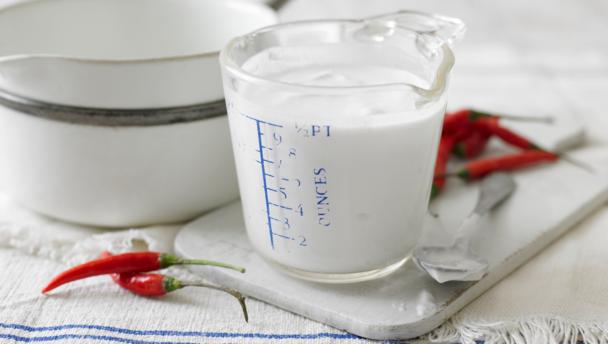

Coconut milk is not the liquid from inside the nut, but the extract of freshly grated coconut flesh. The flesh is first soaked in hot water, then allowed to cool, after which the liquid is strained off. This process that yields both coconut milk and coconut cream. The two liquids will separate when left to stand: the thick white cream will rise to the surface of the liquid leaving the clear watery milk below. Coconut milk gives a distinctive taste and smoothness to curries, sauces and rice.
 Whole eggs in coconut masala (egg molee)
Whole eggs in coconut masala (egg molee)
 Malaysian-spiced noodles with tofu
Malaysian-spiced noodles with tofu
 Thai green curry
Thai green curry
 Pumpkin, chilli and coconut soup
Pumpkin, chilli and coconut soup
 Red lentil soup
Red lentil soup
 Spicy beetroot and coconut soup with herby yoghurt
Spicy beetroot and coconut soup with herby yoghurt
 Spiced cauliflower with toasted coconut and red lentils
Spiced cauliflower with toasted coconut and red lentils
 Thai fishcakes served with Thai cucumber salad
Thai fishcakes served with Thai cucumber salad
 Vegetable pakoras and coconut dal
Vegetable pakoras and coconut dal
 Chocolate fondant puddings with lime syrup and coconut custard
Chocolate fondant puddings with lime syrup and coconut custard
 Chewy coconut macaroons
Chewy coconut macaroons
 Cardamom and beetroot smoothie sundae
Cardamom and beetroot smoothie sundae
 Spiced hot coconut drink
Spiced hot coconut drink
Coconut milk is available canned from Asian and Caribbean stores and larger supermarkets.
If you're dairy-intolerant, coconut milk and cream are an excellent alternative to cows' milk in some cooked dishes (provided you like its quite strong coconut flavour).
Type the ingredients you want to use, then click Go. For better results you can use quotation marks around phrases (e.g. "chicken breast"). Alternatively you can search by chef, programme, cuisine, diet, or dish (e.g. Lasagne).